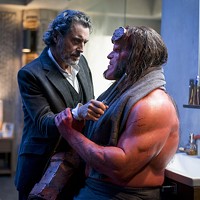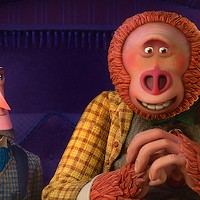

Writer-director Paul Greengrass' superb 9/11 docudrama United 93 is difficult to watch and just as difficult to review. It's one of those movies that should be seen, but it's understandable that many viewers won't want to see it, and no amount of critical hosannas or insistent word-of-mouth will change their minds. While many audiences would find it cathartic or educational, just as many would find it simply too painful to endure, and I can respect that viewpoint.
I'm not going to waste much space on the foolish question -- the sort of soundbite-debate-of-the-moment that news outlets love to seize upon to fill out a slow week -- of whether it's too soon to be making movies centering around 9/11. It's never too soon for any film -- or any other artistic mode of expression, for that matter -- to comment on any event; art doesn't exist in a vacuum, and its vitality in civilization demands that it be allowed to take root according to its own schedule. Instead, the question is how to tackle sensitive subject matter without trafficking in cheap sensationalism; how to honor the material in such a manner that no one's accused of being a profiteer. I daresay that Greengrass passes this test beautifully, as it's hard to imagine a less sensationalized 9/11 film than United 93.
We all know the tragic yet inspiring saga of what happened on this particular airplane on that fateful September day. While the other three planes hijacked by Middle Eastern terrorists all struck their respective targets, United 93 was the only one to fall short of its goal. The passengers were able to band together and cause enough of a disturbance with their captors that the plane ended up crashing in a Pennsylvania field rather than striking its designated target (the movie suggests the Capitol building rather than the White House). United 93 takes us through the morning's activities, beginning with the terrorists praying at dawn and hopscotching through various air traffic control rooms scattered along the northern corridor of the country, as well as the Federal Aviation Administration HQ in Herndon, VA. We see the passengers of United 93 board the plane and settle in with drinks and extra pillows, but the first half of the movie spends more time with the traffic controllers, FAA officials and military advisors who were desperately trying to make sense of the chaos that descended upon them at sickening speed.
When an overheard radio transmission suggests that a hijacking is taking place in the friendly skies, the ground personnel take the threat seriously enough but seem more distracted by the fact that there hasn't been a hijacking in approximately 20 years. In a way, this is uncharted territory for these otherwise highly trained professionals, so their initial fog is understandable. But matters escalate too quickly for anyone to be caught off guard for long. Monitoring the blips on the screens -- the ones representing the myriad flights in the air -- the controllers begin to sweat when particular ones veer off course or disappear completely. And then suddenly, there are those reports that smoke is emanating from one of the World Trade Center towers, in the vicinity where one flight's location was last verified. Surely, one has nothing to do with the other? The implications sicken the characters as much as it churns up roiling emotions in viewers who know how this will all turn out.
During the second half of the film, the connective tissues of the story -- the experiences of the ground personnel -- fall away, and we're exclusively left with the saga unfolding aboard United 93. The pilots are dead, the terrorists have the upper hand, and the passengers are hearing reports (via cell phone calls with loved ones) that a siege has been launched against the United States of America. Eventually, grasping that these ruthless fanatics plan to use the plane as a weapon of mass destruction -- and thereby realizing that no Entebbe-style rescues will be possible -- these ordinary men and women decide that only they can stop the murderers at the controls. It's noble to imagine that the collective gut motive of these passengers was to honor and protect God and country, but this movie is honest enough to acknowledge that, like any of us caught in such a situation, self-preservation comes first: As they huddle to discuss courses of action, much of the talk centers on whether anybody's qualified to fly the plane once they wrest it out of the hands of the terrorists. And it's a testament to the movie's power that we find ourselves praying for a safe landing even though actual history has long dictated otherwise.
I don't mean to pick on filmmakers like Steven Spielberg or Ron Howard -- I have tremendous respect for these practitioners of the trade -- but I shudder to think how this might have turned out in the hands of a Hollywood filmmaker. Would Spielberg, for instance, have been able to resist booking a 10-year-old moppet on the ill-fated flight, and then depicting the final seconds before the plane's crash by zooming in on the raggedy doll that she drops onto the cabin floor? (If you think I'm taking a cheap shot, refer back to the most shameless moment in the otherwise controlled Munich, when Spielberg manufactures suspense over whether a little girl will be the one to pick up a telephone primed to explode.)
Perhaps it was imperative that an outsider tell this story, and that's what we get with Greengrass. A British filmmaker who achieved similar verisimilitude with 2002's Bloody Sunday, a dramatization of the 1972 massacre of Irish civilians by English troops, Greengrass repeatedly refuses to take the bait of making a picture that can be tagged as exploitive, propagandistic or too political (though a couple of ever-so-subtle digs do make it in). How restrained is Greengrass' approach? Understand that passenger Todd Beamer's catchphrase "Let's roll" -- you know, the one that's been co-opted by seemingly every politician, pundit and newshound from coast to coast -- is barely audible when Beamer speaks it in the film, and even then it's not a stand-alone quip but rather part of a string of hurried utterances. Greengrass' insistence on making a respectful movie even extends to the casting, with many of the real-life players confident enough in the project to agree to portray themselves on film (most memorably FAA National Operations Manager Ben Sliney).
Yet Greengrass' restraint can only shelter us for so long. Ultimately, there's no defense against our own humanity, and as the movie forces us to relive the events of that day, it also forces us to relive the emotions. I imagine it's near-impossible to watch United 93 and not be brought to tears on several occasions. Whether such an outpouring of grief and rage will help the healing or tear open old wounds -- well, that's for each man and woman to decide for themselves.
UNITED 93
****
DIRECTED BY Paul Greengrass
STARS Christian Clemenson, Trish Gates


